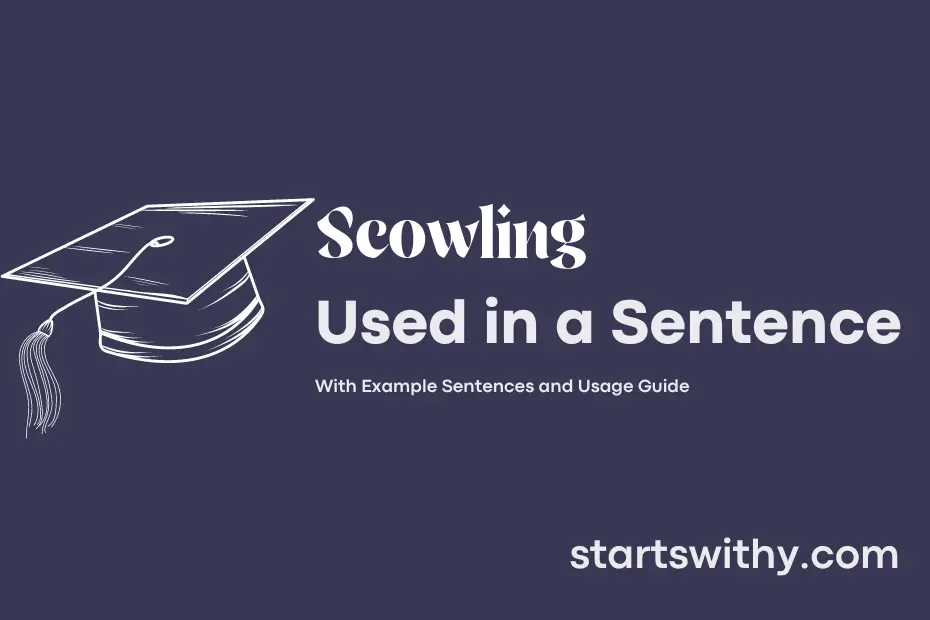Have you ever wondered how to effectively convey a character’s displeasure or anger in writing? One powerful tool for expressing negative emotions in a scene is through the use of the word “scowling.”
“Scowling” is a verb that describes the act of furrowing one’s brow and twisting their facial muscles into an expression of disapproval or displeasure. This word adds a vivid layer to your descriptions, allowing readers to envision the character’s mood and demeanor with clarity. By incorporating “scowling” into your writing, you can create atmosphere and tension in your narrative, enriching the emotional depth of your characters and scenes.
7 Examples Of Scowling Used In a Sentence For Kids
- The scowling pirate wanted all the treasure for himself.
- The teacher was scowling because the students were being noisy.
- The little girl started scowling when she dropped her ice cream cone.
- The scowling cat didn’t want to play with the other kittens.
- The bear was scowling because someone stole his honey.
- The scowling witch cast a spell on the naughty children.
- The scowling lion didn’t like sharing his food with the other animals.
14 Sentences with Scowling Examples
- Scowling at the difficult exam paper, the student desperately tried to remember the answers.
- As the professor announced an unexpected quiz, the students exchanged scowling looks with one another.
- The group project did not go as planned, leaving the team scowling at each other in frustration.
- Scowling at the long line outside the college canteen, the hungry students impatiently waited for their turn.
- The strict librarian caught the students talking loudly and sent them out of the library with a scowling expression.
- After receiving a poor grade on the assignment, the student stormed out of the professor’s office, scowling in disappointment.
- Scowling at the broken printer, the students struggled to submit their assignment on time.
- The noisy neighbors in the dorm room next door had the students scowling as they tried to study for their exams.
- The delayed announcement of exam results had the students scowling with anxiety and impatience.
- Scowling at the malfunctioning projector during their presentation, the students had to improvise quickly.
- The constant interruptions during the online lecture had the students scowling at their unruly siblings.
- Scowling at the expensive textbooks in the college bookstore, the students searched for cheaper alternatives online.
- The sudden power outage during an important online class left the students scowling in frustration.
- Scowling at the slow Wi-Fi connection, the students struggled to submit their online assignments before the deadline.
How To Use Scowling in Sentences?
Scowling is a facial expression that conveys displeasure or anger. Here is a simple guide on how to use scowling in a sentence for beginners:
-
Start by identifying a situation where someone is expressing negative emotions such as anger, disapproval, or irritation.
-
Once you have determined the appropriate context, add the word scowling to describe the person’s facial expression. For example: “She was scowling at her coworker during the meeting.”
-
You can also use scowling to set the tone of a scene or to create a vivid image in the reader’s mind. For instance: “The old man sat on the park bench, scowling at the noisy children playing nearby.”
-
Pay attention to the body language accompanying the scowling expression. This can help provide additional context and depth to your sentence. For example: “The professor crossed his arms, scowling at the students who were late to class.”
-
Experiment with different sentence structures and contexts to practice using scowling effectively. This will help you become more comfortable incorporating the word into your writing.
Remember, using scowling in a sentence can help create a visual image of a person’s emotions, adding depth and realism to your writing.
Conclusion
In conclusion, scowling is a facial expression that conveys disapproval, anger, or displeasure. Scowling involves drawing the eyebrows together and lowering the corners of the mouth, often accompanied by a furrowed brow. It is a nonverbal communication that signifies conflict or dissatisfaction and can create a tense atmosphere between individuals.
Scowling can be seen in various situations, such as during disagreements, when someone is upset, or when expressing disapproval. It is important to be aware of our own scowling expressions and how they may impact others in social interactions. Understanding the meaning behind scowling can help improve communication and prevent misunderstandings, fostering better relationships with those around us.



